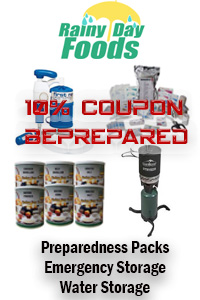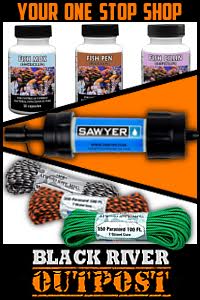I recently spent a few days out in the backcountry wilderness living out of my bag, miles away from the nearest town and long out of cell phone range. It was myself and my dog hiking a few miles a day at over 10,000 feet in elevation, getting in touch with nature and evaluating some gear. When out in that sort of environment one figures out really quickly what is essential and what is fluff with respect to gear, what works and what doesn’t. Since the bugout / survival bag is what we rely on to hold all of our essential equipment it stands to reason that this piece of kit should be near the top of the list with respect to how well it is taken care of. Unfortunately that isn’t the case in many instances, so here are 4 things that might be wrong with your bugout / survival bag.
1- It hasn’t been unpacked in 6 months
Cooler temps are approaching so does the gear in your bag reflect that? How long has it been since you completely emptied your bag, took and inventory and re-packed it? Far too often gear is packed and then allowed to sit which means folks forget what is where and items often expire.
2- It doesn’t have hydration bladder pockets
Water is everything out in the wilderness and you must have a good way to not only carry it but access it while on the move. Many good packs have built in hydration bladder pockets on the sides allowing for a 2 or 3 liter hydration bladder to be stuffed down in them. Run the hose down over the shoulder and drink while on the move, hook up a mini sawyer in line water filter for drinking river/lake water. The days of strapping canteens to a belt or the back of the pack are long gone for most, as there are much improved methods for carrying water.
3- The gear inside it has been chosen based on theory, not practical application.
Folks tend to buy gear based on other people’s opinions and there is nothing wrong with that, but has that gear been tested out in the field? Has the tent actually been set up, fire starting material tested, stove been used to cook food? Maybe there is a hatchet or other cool looking tool in there that is completely unnecessary, only way to find out is to get out there and test the gear.
4- It was purchased wholesale for $25 online.
It’s true, you get what you pay for. To build a quality pack you need quality materials and folks who know what they are doing. Time for design, R&D, manufacturing and advertising. All of these things are built into the cost of the product (a good bag in this case) so that the company can remain profitable. I know this seems like basic information but it stands to reason that a bag that runs $25 on the rack cannot possibly hold a candle to a pack that runs $350 or more. The type of materials in the more expensive pack will be more durable, the zippers and fasteners will be better, the internal frame and shoulder straps will be much more comfortable and on it goes. There are some good compromises out there which folks on a budget can look into but one must be careful when choosing a good bag. Go cheap and by the time mile 5 arrives you’ll be sorry you did.









15 comments
Skip to comment form
Number 1 is a home run. Not only does it keep your gear current but breeds equipment familiarity.
Author
Thanks Ben
Except for #2, this is completely wrong.
I hate these prepper blogs that claim to know it all.
Author
Yet you take the time to comment, thank you! If you could also point me in the direction where I claim to know it all I’d be thankful.
Ha, ha, ya gotta love commenter lines- with all the critics/experts out there, one wonders how we got to needing a website such as this? All points worth pondering no matter-
Comment written by someone guilty of all the above. I’m qwith PJ and Gene on this one. Quality makes a difference and should be balanced.
Way too much theory and arm chair preppers.
While we all make mistakes it helps to be reminded of the basics and all 4 really are basics!
I especially like #3, it is all too common, I think.
Author
You know it J
I like hydration packs too, but not as extra water bladders. They are difficult to refill and cleaning them out is difficult. An extra 2 quart USGI canteen bladder or two is plenty of extra water unless you are in the desert Southwest.
Your bag is too heavy to be carried on foot for more than a short distance…
Author
I’m glad you know what I’m capable of 😉
I think he’s saying that that’s another error that people make. As a former Infantry Squad Leader, I’ve seen this with troops when we headed to the field. Inevitably, we would have to cross-load equipment to make it to the objective. Otherwise, he would be ‘tits up’, and be put in a vehicle.
Now, this could be completely wrong, and he could be saying what you initially thought, but I believe this was his intent. Just my $.02.
#1 Guilty as charged! Easy to under-estimate the ability of mice to damage your gear, all food (mainly energy bars) are now keep in mice-proof, air-tight containers! #2 I must disagree, when you really need potable water, its hard to find at least in the Rockies so I carry 2-2qt. and 1-1qt. (with canteen cup and stove) so I have at least a day worth of water plus the sawyer mini. I’ve seen groups of people (8-10+) carrying only one or two water bottles, relaying on their water filter to restock their containers. Often, they don’t even carry a pot or pan to boil water in, the term ‘dumbass’ comes to mind! Once I played good samaritan to a group of young adults who brang only two water containers for eight people up a long hard mountain trail to the small ‘lake’ up above the tree line. Their water filter came apart at the first attempt to pump water thru it, but I was camping at that same water source so I boiled enough water with my 2qt. pot to rehydrate them all and help them on their way. Not too soon in my book; they were trying start a fire with a couple of logs (4-6′ diameter) with a lighter, no kindling, planning to use a plastic bottle to boil water in, one of them saw that on TV so it must work! GLAHP!
Thanks PJ.
#2: Water definitely is a high priority (rule of 3). While bladders are undoubtedly convenient, I’m not a fan of bladders over containers. In fact I won’t use bladders. Firstly, it’s difficult to measure how much you’re drinking, and you can’t readily assess how much you’ve got left. Secondly, it’s not hard to puncture them and once they are punctured or burst you’re up a well known creek. Thirdly, you can’t boil water in them. If you need to purify water, boiling is one of the most effective methods of purification. Stainless Steel containers or Cups Canteen Steel will provide you with that capability. I’d much rather have two old style water bottles each with a cups canteen steel, and a number of stainless steel water bottles. I’ll suffer the extra weight for the benefit of being able to boil water and cook in them. And once you’ve used all your water, it’s great to have a Life Straw type filter as an emergency backup, and a pump filter like a Katadyne or MSR that you can use to refill containers. Of course it all adds to the weight, but if you don’t drink, you die.
#3. I love technology. I’m always looking for that new bit of kit that will work better or save me weight or space. But the best equipment in the world is of limited value if you don’t know how to use it. Worse still, what if you lose your pack? It could fall down a ravine or be taken from you. Survival starts with what’s in your head. And that includes the knowledge of how to survive without all those wonderful bits of kit that you’ve collected!
Thanks for your thoughts.
Unpacking the pack on a regular basis is super important, you never know when bugs or mold may have ruined clothing. Plus sleeping bags and lofty clothes can get ruined if always compacted.